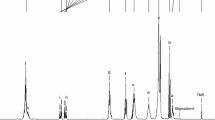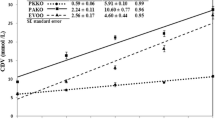Abstract
Vegetable oils are subjected to heat treatments during processing and changes during storage. Thus, it is required, for usage as a food source, the evaluation of their thermo-oxidative stability and physicochemical characteristics. In this context, the objective of this paper was to evaluate the oil of catole coconut (Syagrus cearensis), aiming to characterize its identity and quality, as well as its antioxidant capacity and thermo-oxidative stability. The catole coconut was collected in the city of Lagoa Seca-PB, Brazil, its almonds were dried in a stove and the catole oil was obtained by cold pressing. The results of the physicochemical parameters complied with the current legislation, with average values of 2.48 mg KOH g−1 oil for acid value, 0.14 meq peroxide kg−1 oil for peroxide value and 253 mg KOH g−1 oil for saponification value. Catole oil presented the profile of saturated fatty acids (84.42%), with the predominance of lauric acid (45.06%), besides major phenolic compounds such as salicylic acid [12.324 mg (100 g−1) of oil] and myricetin [1.405 mg (100 g−1) of oil]. The thermogravimetric profile remained stable to decomposition at temperatures up to around 240 °C and oxidative stability withstood at 110 °C for more than 48 h. Therefore, it was possible to identify and characterize this unexplored oilseed species of the Brazilian semiarid, diversifying its use in the food industry.



Similar content being viewed by others
References
Do Nascimento VT, De Moura NP, Da Silva Vasconcelos MA, Maciel MIS, De Albuquerque UP. Chemical characterization of native wild plants of dry seasonal forests of the semi-arid region of northeastern Brazil. Food Res Int. 2011;44:2112–9. https://doi.org/10.1016/j.foodres.2010.12.024.
Silva RB, Silva-Júnior EV, Rodrigues LC, Andrade LHC, DA Silva SI, Harand W, et al. A comparative study of nutritional composition and potential use of some underutilized tropical fruits of Arecaceae An Acad Bras Cienc. Acad Brasil Ciências. 2015;87:1701–9.
Leal LB, Sousa GD, Seixas KB, de Souza PHN, de Santana DP. Determination of the critical hydrophile-lipophile balance of licuri oil from Syagrus coronata: application for topical emulsions and evaluation of its hydrating function. Braz J Pharm Sci. 2013;49:167–73.
Kumar SN. Variability in coconut (Cocos nucifera L.) germplasm and hybrids for fatty acid profile of oil. J Agric Food Chem. 2011;59:13050–8.
Hughes C, Fenical W. Antibacterials from the sea. Chem Eur J. 2010;16:12512–25.
Coimbra MC, Jorge N. Fatty acids and bioactive compounds of the pulps and kernels of Brazilian palm species, guariroba (Syagrus oleraces), jerivá (Syagrus romanzoffiana) and macaúba (Acrocomia aculeata). J Sci Food Agric. 2012;92:679–84.
André C, Castanheira I, Cruz JM, Paseiro P, Sanches-Silva A. Analytical strategies to evaluate antioxidants in food: a review. Trends Food Sci Technol. 2010;21:229–46.
Maganha EG, da Halmenschlage R C, Rosa RM, Henriques JAP, de RamosAll P, Saffi J. Pharmacological evidences for the extracts and secondary metabolites from plants of the genus Hibiscus. Food Chem. 2010;118:1–10.
AOCS. Official Methods and Recommended Practices of the American Oil Chemists' Society. USA: Champaign; 2014.
AOAC Association of Official Analytical Chemists. Official methods of analysis of AOAC International.19 ed. Washington, D.C.; 2000.
ASTM D4052. Standard Test Method for Density ,Relative Density , and API Gravity of Liquids by Digital Density Meter; 2015.
Hartman L, Lago RC. Rapid preparation of fatty acid methyl esters from lipids. Lab Pract. 1973;22:475–6.
Alcântara MA, de Lima AEA, Braga ALM, Tonon RV, Galdeano MC, da Mattos MC, et al. Influence of the emulsion homogenization method on the stability of chia oil microencapsulated by spray drying. Powder Technol. 2019;354:877–85.
Khattab RY, Zeitoun MA. Quality evaluation of flaxseed oil obtained by different extraction techniques. LWT Food Sci Technol. 2013;53:338–45.
Carrasco-Pancorbo A, Gómez-Caravaca AM, Cerretani L, Bendini A, Segura-Carretero A, Fernández-Gutiérrez A. A simple and rapid electrophoretic method to characterize simple phenols, lignans, complex phenols, phenolic acids, and flavonoids in extra-virgin olive oil. J Sep Sci. 2006;29:2221–33.
EN 14112. Standard fat and oil derivatives—Fatty acid methyl esters ( FAME )—Determination of oxidation stability (Acelerated Oxidation Test). 2016.
Codex Standard for named vegetable oils. Codex Standard for fats and oils from vegetable sources. CODEX-STAND 210; 2009.
Liau KM, Lee YY, Chen CK, Rasool AHG. An open-label pilot study to assess the efficacy and safety of virgin coconut oil in reducing visceral adiposity. ISRN Pharmacol. 2011;2011:1–7.
AOCS—Official Methods and Recommended Pratices of the AOCS. 5 ed. American Oil chemist Society: Champaing, Illinois; 2004.
Visconde Brasil R, Luiz Â, Cavallieri F, Luíza A, Costa M, Ássima M, et al. Caracterização física e química do óleo de pequi exposto a diferentes condições de armazenamento. 2010.
Granato D, Nunes D. Análises químicas, propriedades funcionais e controle de qualidade de alimentos e bebidas: uma abordagem teórico-prática. 2017.
Duarte PH. Otimização da síntese e caracterização do biodiesel metílico e etílico do óleo de licuri (Syagrus coronata), e adição de ésteres metílicos como aditivo em blendas de biodiesel de soja. Ituiutaba; 2018.
Ricardo WMT, Bernardo CF, Feroldi M, Cremonez P, Talita SL, Bonassa G, et al. Evaluation of production of methyl esters and glycerol afrom mixtures of residual oil, soybean and canola. Rev Tecnológica. 2015; Special Edition 2014:73–81.
Correia IMS, Araújo GS, Paulo JBA, De Sousa EMBD. Avaliação das potencialidades e características físico- químicas do óleo de Girassol (Helianthus annuus L.) e Coco (Cocos nucifera L.) produzidos no Nordeste brasileiro. Scientia plena. 2014;10:1–7.
Martins JS, Santos JCO. Estudo comparativo das propriedades de óleo de coco obtido pelos processos industrial e artesanal. An do 5° Encontro Reg Química 4° Encontro Nac Química. São Paulo: Editora Edgard Blücher; 2015. pp. 515–26.
de Camargo AC, Regitano-d’Arce MAB, de Alencar SM, Canniatti-Brazaca SG, de Souza Vieira TMF, Shahidi F. Chemical changes and oxidative stability of peanuts as affected by the dry-blanching. J Am Oil Chem Soc. 2016;93(8):1101–9.
Mansor TST, Man YC, Shuhaimi M, Afiq MA, Nurul FK. Physicochemical properties of virgin coconut oil extracted from different processing methods. Int Food Res J. 2012;19(3):837.
Assunção ML, Ferreira HS, dos Santos AF, Cabral CR, Florêncio TMMT. Effects of dietary coconut oil on the biochemical and anthropometric profiles of women presenting abdominal obesity. Lipids. 2009;44:593–601.
Collado MC, Isolauri E, Laitinen K, Salminen S. Effect of mother’s weight on infant’s microbiota acquisition, composition, and activity during early infancy: a prospective follow-up study initiated in early pregnancy. Am J Clin Nutr. 2010;92:1023–30.
Faria JP, Arellano DB, Grimaldi R, Silva LCR. Caracterização química da amêndoa de coquinho-azedo (Butia capitata var capitata). Rev Bras Frutic. Sociedade Brasileira de Fruticultura; 2008.
Halliwell B, Gutteridge JMC. (2015) Free radicals in biology and medicine. 5th ed. Oxford, United Kingdom; 2015.
Nelson DL, Cox MM. Princípios de Bioquímica de Lehninger. 6th ed. New York; 2014.
Baynes JW, Dominiczak MH. Bioquímica Médica. 5th ed. Elsevier; 2019.
Grosser T, Smyth E, FitzGerald GA. Anti-inflammatory, antipyretic, and analgesic agents; pharmacotherapy of gout. Goodman and Gilman’s the pharmacological basis of therapeutics. New York: McGraw-Hill; 2011. p. 959–1004.
Knekt P, Kumpulainen J, Järvinen R, Rissanen H, Heliövaara M, Reunanen A, et al. Flavonoid intake and risk of chronic diseases. Am J Clin Nutr. 2002;76:560–8.
Redondo-Cuevas L, Castellano G, Torrens F, Raikos V. Revealing the relationship between vegetable oil composition and oxidative stability: a multifactorial approach. J Food Compos Anal. 2018;66:221–9. https://doi.org/10.1016/j.jfca.2017.12.027.
García-Moreno PJ, Pérez-Gálvez R, Guadix A, Guadix EM. Influence of the parameters of the Rancimat test on the determination of the oxidative stability index of cod liver oil. LWT Food Sci Technol. 2013;51:303–8.
Maszewska M, Florowska A, Dłuzewska E, Wroniak M, Marciniak-Lukasiak K, Zbikowska A. Oxidative stability of selected edible oils. Molecules. 2018;23:15–7.
Moigradean D, Poiana M-A, Gogoasa I. Quality characteristics and oxidative stability of coconut oil during storage. J Agroaliment Process Technol. 2012;18:272–6.
Chacon G, Maria DC, Vitória DF, Heloísa DM, Clemente G. Influence of the atmosphere on the decomposition of vegetable oils : study of the profiles of FTIR spectra and evolution of gaseous products. J Therm Anal Calorim. 2020;140:2247–58. https://doi.org/10.1007/s10973-019-08960-9.
Santos AG, Caldeira VP, Souza LD, Oliveira DS, Araujo AS, Luz GE. Study of the thermal stability by thermogravimetry for oil, biodiesel and blend (B10) of different oilseeds. J Therm Anal Calorim. 2016;123(3):2021–8. https://doi.org/10.1007/s10973-015-4943-z.
Faria EA, Leles MIG, Ionashiro M, Zuppa de TO, Antonio Filho NR. Estudo da estabilidade térmica de óleos e gorduras vegetais por TG/DTG e DTA. Eclética Química 2002;27.
Farhoosh R, Moosavi SMR. Rancimat test for the assessment of used frying oils quality. J Food Lipids. 2007;14:263–71.
Volli V, Purkait MK. Physico-chemical properties and thermal degradation studies of commercial oils in nitrogen atmosphere. Fuel. 2014;117:1010–9.
Caeser A, Portella F, Munaro M, Donizete Ascêncio S, De C, Siqueira A, et al. Caracterização físico-química do óleo essencial da Siparuna guianensis Aublet. Quim Nov. 2014;37:844–9.
Mosarof MH, Kalam MA, Masjuki HH, Arslan A, Monirul IM, Ruhul AM, et al. Analysis of thermal stability and lubrication characteristics of Millettia pinnata oil. RSC Adv. 2016;6:81414–25.
Melo E, Michels F, Arakaki D, Lima N, Gonçalves D, Cavalheiro L, et al. First study on the oxidative stability and elemental analysis of Babassu (Attalea speciosa) edible oil produced in Brazil using a domestic extraction machine. Molecules. 2019;24:4235.
Gharby S, Hicham H, Boulbaroud S, Bouzoubaâ Z, el Madani N, Chafchaouni I, et al. The stability of vegetable oils (sunflower, rapeseed and palm) sold on market at high temperature. Int J Chem Biochem Sci. 2014;5:47–54.
Ayyildiz HF, Topkafa M, Kara H, Sherazi STH. Evaluation of fatty acid composition, tocols profile, and oxidative stability of some fully refined edible oils. Int J Food Prop. 2015;18:2064–76.
Rohman A, Che Man YB. Application of FTIR spectroscopy for monitoring the stabilities of selected vegetable oils during thermal oxidation. Int J Food Prop. 2013;16:1594–603.
Castilho-Almeida EW, Santos HFD, Miranda AMD, Jorio A, Ferreira EHM, Achete CA, Almeida WBD. Estudo teórico e experimental de espectros infravermelho de ésteres de ácido graxo presentes na composição do biodiesel de soja. Quim Nova. 2012;35(9):1752–7.
Guillén MD, Cabo N. Some of the most significant changes in the Fourier transform infrared spectra of edible oils under oxidative conditions. J Sci Food Agric. 2000;80:2028–36.
Muik B, Lendl B, Molina-Diaz A, Valcarcel M, Ayora-Cañada MJ. Two-dimensional correlation spectroscopy and multivariate curve resolution for the study of lipid oxidation in edible oils monitored by FTIR and FT-Raman spectroscopy. Anal Chim Acta. 2007;593:54–67.
Acknowledgements
The authors acknowledge Universidade Federal da Paraíba, Brazil, and its Research and Extension Nucleus of the Fuel Laboratory for the physical and structural conditions for conducting the analyses and the Higher Education Personnel Improvement Coordination (CAPES), Brazil, and the Graduation Support Program. (PROAP), Brazil, for the financial support for the accomplishment of this work.
Author information
Authors and Affiliations
Corresponding author
Ethics declarations
Conflict of interest
The authors declare the absence of conflict of interest.
Additional information
Publisher's Note
Springer Nature remains neutral with regard to jurisdictional claims in published maps and institutional affiliations.
Rights and permissions
About this article
Cite this article
Meireles, B.R.L.A., Alcântara, M.A., Polari, I.d. et al. Catole coconut (Syagrus cearensis) oil: physicochemical characterization and thermo-oxidative stability by TG/DTG/DTA and Rancimat. J Therm Anal Calorim 147, 3591–3598 (2022). https://doi.org/10.1007/s10973-021-10789-0
Received:
Accepted:
Published:
Issue Date:
DOI: https://doi.org/10.1007/s10973-021-10789-0




